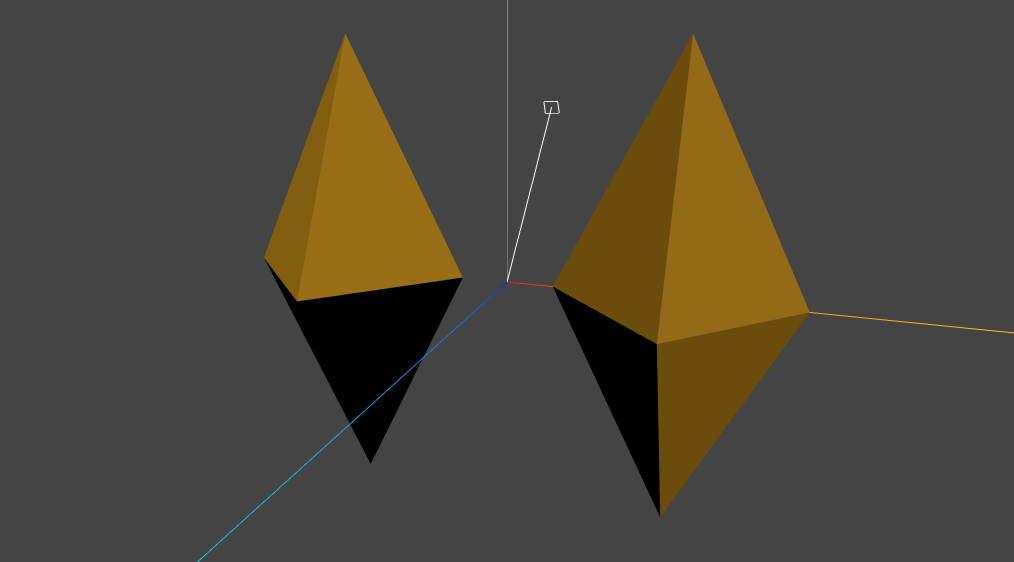InstancedMesh uses an incorrect normal matrix
See original GitHub issueAs discussed here.
The vertex normal should be transformed by the normal matrix computed from the instanceMatrix.
In this image, the mesh on the left is an InstancedMesh having a single instance. The image on the right is a non-instanced Mesh. They should have identical shading.

Three.js version
- [ x ] r113 dev
- [ x ] r112
Issue Analytics
- State:
- Created 4 years ago
- Comments:6 (4 by maintainers)
 Top Results From Across the Web
Top Results From Across the Web
Problem with normals when drawing instanced mesh
The solution was relatively simple: there is no point in passing a normal-matrix to the shader. Instead, the normal needs to be computed...
Read more >InstancedMesh from GLTF doesn't work?! - three.js forum
Hi, InstancedMesh ([1] in code) doesn't work when geometry loaded from GLTF - is this a bug or I'm doing smth wrong?! When...
Read more >Incorrect normals on after rotating instances [Graphics ...
I am currently passing positions and rotations in two seperate ComputeBuffers (using a Vector3 array and a Quaternion array respectively) and in ...
Read more >InstancedMesh | Babylon.js Documentation
If true (default false) and and if the mesh geometry is shared among some other meshes, the returned array is a copy of...
Read more >aframe-instanced-mesh - npm
This can be useful for raycasting or physics body shape configuration on instanced Mesh members. false. colors, array, an array of colors to...
Read more > Top Related Medium Post
Top Related Medium Post
No results found
 Top Related StackOverflow Question
Top Related StackOverflow Question
No results found
 Troubleshoot Live Code
Troubleshoot Live Code
Lightrun enables developers to add logs, metrics and snapshots to live code - no restarts or redeploys required.
Start Free Top Related Reddit Thread
Top Related Reddit Thread
No results found
 Top Related Hackernoon Post
Top Related Hackernoon Post
No results found
 Top Related Tweet
Top Related Tweet
No results found
 Top Related Dev.to Post
Top Related Dev.to Post
No results found
 Top Related Hashnode Post
Top Related Hashnode Post
No results found

FWIW normal matrix isn’t the only way to transform normals, assuming the object matrix uses rotation and (non-uniform) scale there’s an alternative formulation.
I’m going to use column vectors below, so the vertex transform is
T*R*S*vwith a decomposed matrix. The canonical formulation for normal matrix suggests usingNM = inverse(transpose(R*S)).inverse(transpose(R*S)) = inverse(transpose(S) * transpose(R)) = inverse(transpose(R)) * inverse(transpose(S)), where R is a rotation matrix and S is a diagonal matrix with scale values for each axis.inverse(transpose(R)) = R, andtranspose(S) = S, so the above is equal toR * inverse(S), which is equal toR * S * inverse(S) * inverse(S).Thus it’s sufficient to pre-transform the object-space normal using
inverse(S)^2- since S is a diagonal, if you know the scale values this just involves dividing the normal by scale^2.You can recover the scale values from the combined R*S matrix by measuring the length of basis vectors.
This shader code illustrates the construction:
The cost of this correction is three dot products and a vector division, which seems reasonable. If both instance matrix and object matrix can carry non-uniform scale then I think you will need to run this code twice.
Something like this could be used as a generic normal transform function (assuming a normalization step is ran after this):
edit The above assumes that the transform matrix can be decomposed into R*S, which isn’t true of an arbitrary sequence of rotation-scale transforms, but is probably true for instance matrix transform - so I’m assuming this can be combined with using normalMatrix for handling the general scene graph transform. So this might be useful not as a replacement for existing normalMatrix, but purely as a way to correct instanceMatrix transformation in the shader.
For the current
InstancedMeshAPI, I think the fix proposed in this thread is reasonable.